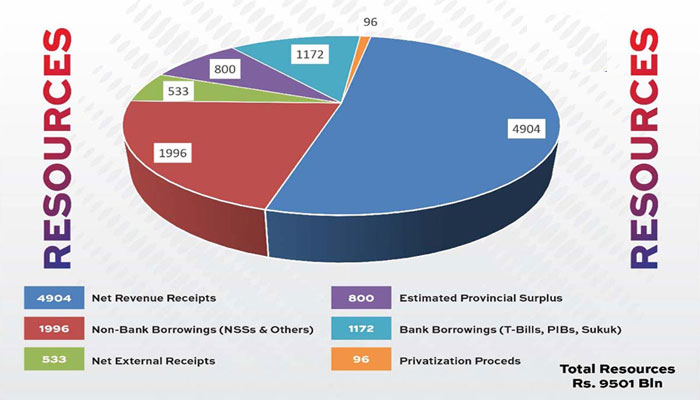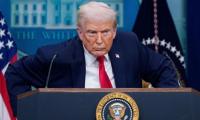Analysis: A pragmatic budget
A 5pc GDP growth target for FY23 is neither advisable nor likely and the IMF programme will be secured, allowing friendly countries to retain support and the government to refinance debt
Caught between a rock (IMF) and a hard place (popularity), the commodity supercycle and devaluation came to the government’s rescue to help bridge the tax revenue target through higher import values.
This allowed the FM to limit the impact of additional taxes and find the space to retain some element of growth. However, a 5pc GDP growth target for FY23 is neither advisable nor likely. The IMF programme will be secured, allowing friendly countries to retain support and the government to refinance debt. The dilemma is that inflation, which undermines government’s popularity, will help it meet the tax revenue target and secure the IMF programme.
However, reliance on the commodity supercycle to meet revenue targets is not a sustainable solution and mini-budgets can be expected if it subsides.
Devoid of political will to broaden the tax base, the budget uses the traditional formulae of taxing the taxed through windfall tax on companies and individuals earning over Rs300 million, 3pc higher tax on banks and compression of salary tax slabs. It could have been worse for the formal sector. At least, some direction is visible in taxing immoveable property. Import levies are to be rationalised on 400 lines to promote manufacturing, initial allowance on capital expenditure has been doubled and non-filers will have to pay advance tax at twice the rate hitherto applicable on purchase of 1600cc and larger cars.
To its credit, the government has reversed the retrogressive sales tax on solar equipment and seeds. Also, agricultural equipment will be exempted from import duty. An industrial policy is being developed and SEZs are to be accelerated to promote investment. Promises of prompt refund of taxes and payment of rebates have been made in the past. There is a need to walk the talk. Imports are forecast to decline and exports to rise. However, there are no visible measures in the budget to facilitate this.
Notwithstanding, a 20-year-old crisis of funding a bloated government, losses of state-owned enterprises and mounting debt service charges, the government found space to increase government wages and pensions.
The FM had an unenviable task of making a budget under tough conditions. Whilst business expected reversal of double taxation of intercorporate dividends and restoration of incentive to list companies on the PSX, this will need to wait. Resources need to be deployed on more focused and targeted subsidies to the poor.
The writer is CEO of Pakistan Business Council.
-
 Alexander Skarsgard Breaks Silence On Rumors He Is Bisexual
Alexander Skarsgard Breaks Silence On Rumors He Is Bisexual -
 King Charles Faces Rift With Prince William Over Prince Harry’s Invictus Games
King Charles Faces Rift With Prince William Over Prince Harry’s Invictus Games -
 Elon Musk’s Critique On ChatGPT Safety Draws Sharp Response From Sam Altman
Elon Musk’s Critique On ChatGPT Safety Draws Sharp Response From Sam Altman -
 Katherine Ryan Takes Aim At Brooklyn Beckham In Fierce Defense Of His Parents
Katherine Ryan Takes Aim At Brooklyn Beckham In Fierce Defense Of His Parents -
 How Timothy Busfield, Melissa Gilbert Really Feel After Release From Jail
How Timothy Busfield, Melissa Gilbert Really Feel After Release From Jail -
 OpenAI, Bill Gates Launch ‘Horizon 1000’ To Transform AI Healthcare In Africa
OpenAI, Bill Gates Launch ‘Horizon 1000’ To Transform AI Healthcare In Africa -
 Prince Harry Receives Praises For Exposing Dark Side Of British Tabloids
Prince Harry Receives Praises For Exposing Dark Side Of British Tabloids -
 Andrew Forces Beatrice, Eugenie To Lose $60 Million Safety Net Saved For Retirement
Andrew Forces Beatrice, Eugenie To Lose $60 Million Safety Net Saved For Retirement -
 Nvidia CEO Jensen Huang To Visit China To Push Re-entry Into AI Chip Market
Nvidia CEO Jensen Huang To Visit China To Push Re-entry Into AI Chip Market -
 U.S. On Verge Of Losing Measles-free Title Due To Outbreak
U.S. On Verge Of Losing Measles-free Title Due To Outbreak -
 Harry Styles Excites Fans As He Announces Release Date Of New Song
Harry Styles Excites Fans As He Announces Release Date Of New Song -
 Japan’s Ex-PM Shinzo Abe’s Killer Is Set To Be Sentenced: How Much Punishment Could He Face?
Japan’s Ex-PM Shinzo Abe’s Killer Is Set To Be Sentenced: How Much Punishment Could He Face? -
 Prince Harry, Meghan Markle’s Return To UK Could Create Royal Family Dilemma
Prince Harry, Meghan Markle’s Return To UK Could Create Royal Family Dilemma -
 Prince Harry Turns Troubled With No Sense Of Home: ‘Isolation Is Getting To Him Mentally’
Prince Harry Turns Troubled With No Sense Of Home: ‘Isolation Is Getting To Him Mentally’ -
 Vitamin D Link To Respiratory Diseases Will Shock You
Vitamin D Link To Respiratory Diseases Will Shock You -
 A$AP Rocky Gives His Take On Children's Budding Personalities
A$AP Rocky Gives His Take On Children's Budding Personalities




